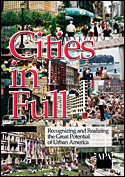The five word answer to why it is so difficult to revitalize neighborhood commercial districts in DC
We don't have enough people.
-------------
Here's something I wrote this weekend in an email thread on urban transit systems:
... I was thinking that I neglected to mention the most important thing, which I just took for granted. And that is urban design + density. Typically, it's easy to knock "next generation transit" systems because they are attempts to put the genie back in the bottle. [Added -- next generation transit systems are those like BART, MARTA, WMATA etc. that were built in the 1960s and 1970s. Urban design refers to the grid pattern of relatively small blocks that typifies the L'Enfant City.]

Since the dominant development pattern in the U.S. is deconcentration and a much greater per capita use of space in all metropolitan regions, it's almost impossible for new transit systems to repattern development, except on very long time frames, even if TOD and other pro-transit policies are in place (i.e., keeping commercial development in the core, reducing or eliminating free parking, etc.)
When transit competes against free parking, and people's failure to adequately account for sunk cost in computing trip costs, often transit doesn't appear to be an equivalently sound economic choice. (Peter Newman's work on the economic value of transit in terms of building wealth at the regional level is a good counter to this kind of thinking.)
But when you live in a place with enough density (and DC is just barely on the cusp of having enough density, most residents think there is too much and the sad reality is that most places don't have enough people to support neighborhood-based amenities especially retail, which is why neighborhood commercial district revitalization is so hard even so) you can support relatively frequent transit services, and with complementary development practices, and livability, you see how it works. [emphasis added]
That being said it took more than 20 years for the pieces to come together in the core of DC, I mean 20 years after most of the system was built out in the core.

And I mention the core, because the one thing only that I have probably ever thought of that Steve Belmont in Cities in Full didn't already write is this:
Belmont justly criticizes the other problem with next generation transit systems is that they are about polycentricity, not recentralization, and he criticizes the WMATA system for being polycentric, and not having much success in terms of densification in the outer suburbs (not Arlington).
Belmont's absolutely right.

Figure from Cities in Full.
But he doesn't take into account that at the core of DC, the WMATA system functions monocentrically, almost like the MUNI system in SF vis-a-vis BART. There you have great transit, more density, more neighborhood amenities. That's why almost every one of those neighborhoods has revitalized or is well on the way, and that is despite the relative under-density (most DC rowhouses are two stories).

Subway stations at the core of the city of Washington.
Labels: commercial district revitalization, density, mixed use



0 Comments:
Post a Comment
<< Home